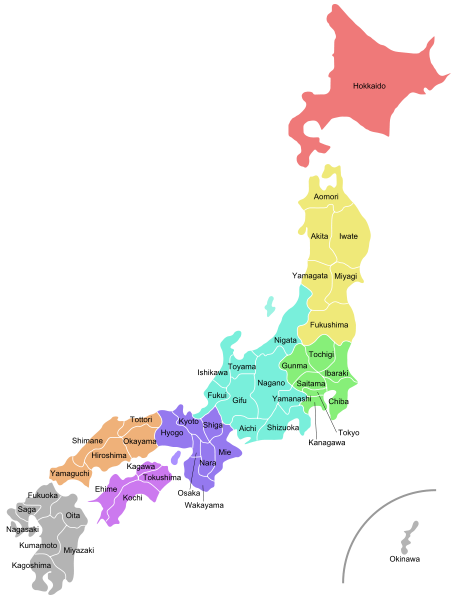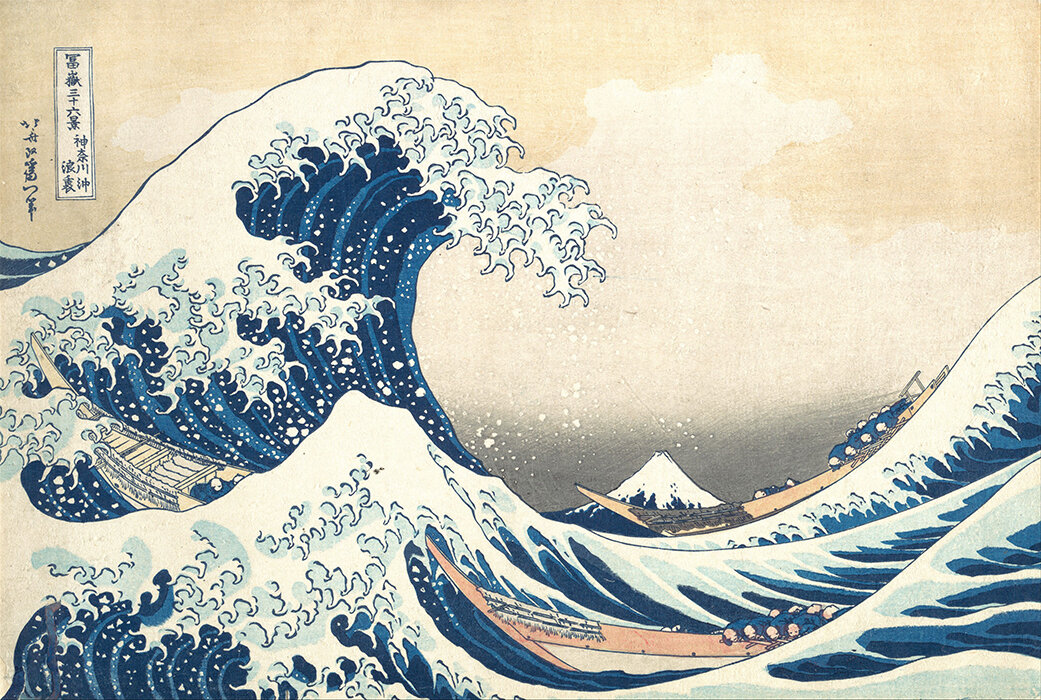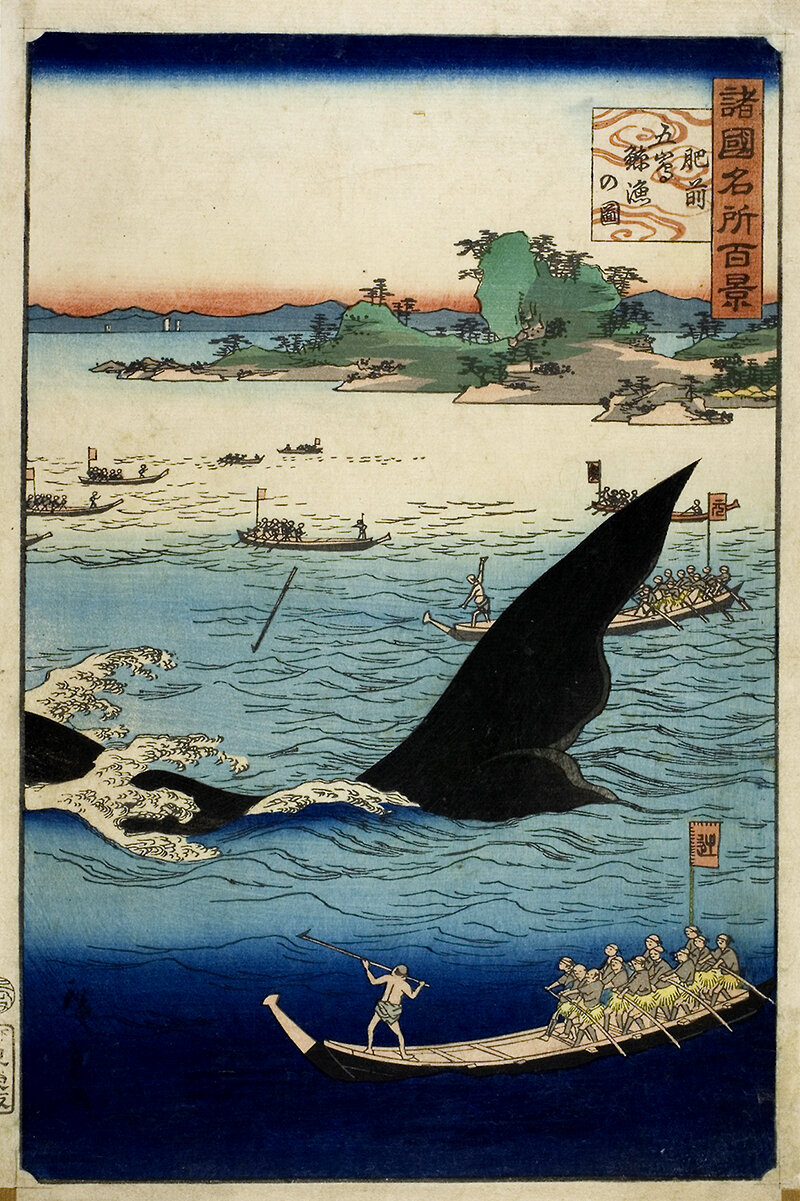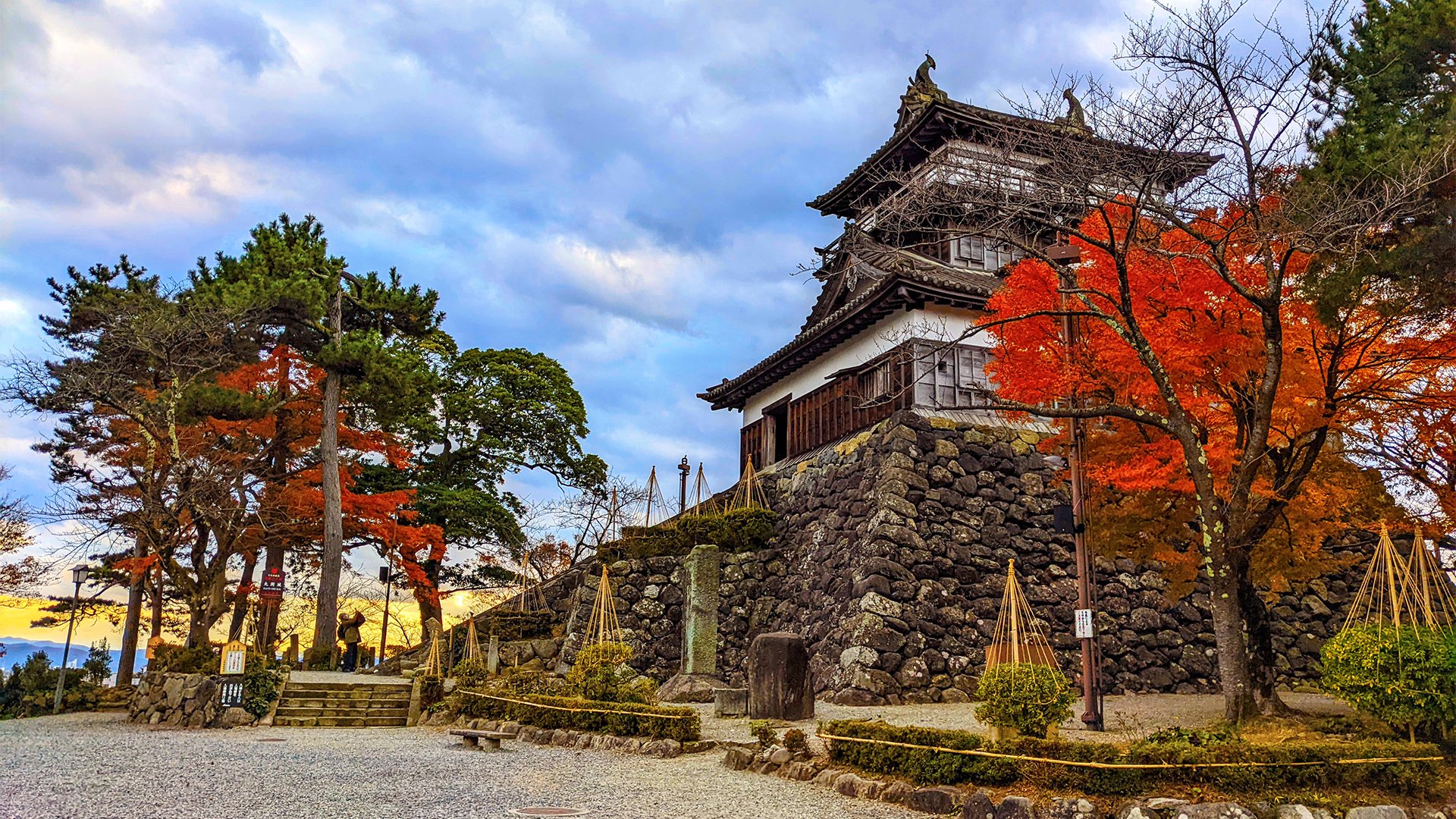Work as Self-Sacrifice by Hiroshige

Master Artisan Utagawa Hiroshige depicts the dangerous divisions of labor in Edo Japan and the enduring culture of self-sacrifice rooted in Confucian ethics.
Cover photo: Whale Hunting at Goto, Hizen Province (Hizen Goto geiryo no zu), from the series “One Hundred Famous Views in the Various Provinces (Shokoku meisho hyakkei)”, ukiyo-e woodblock print, by Utagawa Hiroshige II (1859). Via the Art Institute of Chicago.
The Art of Labor
At the height of the Industrial Revolution in the United States, American workers — including children — suffered twelve hour work days and seven day work weeks. Labor Day originated in 1882 as an annual mass rally in New York organized by socialists and leftist organizations to demand shorter hours, higher pay, safer working conditions, and a labor holiday. President Grover Cleveland would declare Labor Day a federal holiday in 1894.
COVID-19 has revealed who are the essential workers and who performs the unnecessary “bullshit jobs”. This once-in-a-century pandemic has also demonstrated the global interdependency of resources, labor, and supply chains — what we commonly refer to as globalization.
Millions of Americans have lost their jobs, and likely their healthcare. This has inspired me to create a new series on the art of labor through the centuries, with a focus on how work has been valued and represented.
Edo Japan
Edo period Japan was ruled by the Tokugawa Shogunate from 1603 until 1867. The era was characterized by total control, stability, and peace as the Shogunate adopted strict policies of seclusion and class separation. By 1800, Edo (present-day Tokyo) is estimated to have been the largest city in the world.
According to the Metropolitan Museum of Art, “By the late 1630s, contact with the outside world was cut off through official prohibition of foreigners. In Japan’s self-imposed isolation, traditions of the past were revived and refined, and ultimately parodied and transformed in the flourishing urban societies of Kyoto and Edo. Restricted trade with Chinese and Dutch merchants was permitted in Nagasaki”.
In his ukiyo-e print Places of Entertainment in the Eastern capital, artist Katsushika Hokusai depicts curious Nagasaki residents catching a glimpse of Dutch traders, confined to a lodging house.
The success of Edo Japan was founded on the bakuhan system, an all-encompassing socio-political economic structure composed of “two opposite aspects: the highly developed money economy on the part of the lord and the urban merchants, and the self-sufficient economy on the part of the peasant,” as explains historian Keiji Nagahara.
Confucianism and Class
Historian Shinzaburō Ōishi writes, “the bakuhan system contributed to the stability and order of the time.” Class rigidity was a key component. The Edo period’s strict class structure composed of samurai (warriors), peasants (farmers and fisherman), artisans (artists, craftsman, and manufacturers), and merchants. The samurai class was the smallest of the four, just barely 7%, while the peasantry was by far the largest class, comprising over 80% of the population.
Edo Japan is reminiscent of feudal Europe as all land was owned by the elite classes of the Shogun and the Daimyo. Peasants paid rent in rice, taken from their surplus in harvest. These taxes ranged from 40 to 60 percent. In addition to the national policy of isolation, peasants were “utterly deprived of the freedom of movement” and prohibited from any travel. Those who attempted to move were “arrested and taken back to their villages.”
China scholar Robert Oxnam writes, “The Tokugawa social hierarchy was based on Chinese Confucian notions of classes.” Economist Wei-Bin Zhang explains, “Tokugawa Confucianists had chosen group loyalty above filial piety to harmonise the new system with traditional groupism. Loyalty to one’s lord took precedence over all other obligations.”
Inequality was justified by the division of labor which, in turn, justified inequality. Professor of Philosophy Chenyang Li describes the tautology, “Confucian proportional equality rests on the belief that an orderly and functional society must be one with effective divisions of labor, and that with divisions of labor comes social stratification. Divisions of labor, however, are not arbitrary; they should be based on people’s abilities.”
“The shogun Tokugawa leyasu (1542-1616) and his followers further solidified the four-class structure of samurai, farmers, artisans, and merchants,” writes Robert T. Singer in the book Edo Art in Japan. “Success hinged on a clear understanding and respect for hierarchy, not only among the four classes but within each class, community, and family.”
Like in many Western traditions, manual labor was generally considered unworthy of respect. Zhang notes, “The samurai are superior and use their minds; the rest are inferior and use their muscles.”
“Artisans and merchants, the third and fourth classes, respectively, served the samurai from their shops in the castle towns and eventually dominated the class of townspeople (chônin).” Singer adds, “Therefore, those with the least political authority came to control much of the country’s wealth. The new power held by this group of sellers — who were also consumers — is evidenced by their increasing importance as a theme in art”.
Ultimately, Singer concludes, “The new order of Japanese society had the subsidiary effect of promoting workers as an idea in art, making them a symbol of prosperity, an archetype of peaceful living, and an emblem of a country rebuilding after a century of war.”
Zhang writes, “Tokugawa Confucianism, as formed in the early 17th century, served Japan until the opening of the country to outsiders in 1854.” The following era of Meiji Japan would not result in meaningful changes to social roles.
Professor of the history of religions Winston Davis observes, “What then could one make of the differences in wealth, power, and ability pandemic in human affairs? Japanese Buddhists sanctioned these differences with the slogan “discrimination (or difference) is equality; equality is discrimination” (shabetsu-soku-byodo; byodo-soku-shabetsu). In Meiji Japan, the ideal of a discriminating egalitarianism could, and easily did, accommodate a considerable degree of inequality.”
Researcher Gregory K. Ornatowski sums, that this concept was employed “by many Buddhists to justify the growing social and economic inequalities brought about by the rise of capitalism.”
The Treaty Of Kanagawa
The Edo period came to an abrupt end after the American Navy sailed to Japan in the mid-19th century. On July 8th, 1853, Commodore Matthew Perry anchored his ships in Edo Bay.
According to the U.S. National Archives, “The Fillmore administration sent Commodore Matthew C. Perry and a small fleet of sloops and the latest steam-powered ships to go to Edo (Tokyo) Bay to insist on a treaty that would protect the rights of American whalers, provide for coaling ports, and eventually lead to trade.”
In the waters near Edo, Perry positioned his ships’ cannons towards the city. Perry demanded to deliver a letter from President of the United States, Millard Fillmore, to the Emperor of Japan.
By September, Chief Senior Councilor Abe Masahiro at Edo Castle agreed to lift the ban on building, owning, or operating ocean-worthy vessels. The first international treaty in the history of Japan — the Treaty of Kanagawa — was signed less than a year later, on March 31st, 1854, upon Perry’s return, opening the previously isolated Japan to globalized commerce.
Kanagawa is a prefecture (administrative district) just south of Tokyo, home to Japan’s second-largest city, Yokohama. The era of Meiji Restoration would begin in 1868. Prefectures would be established in 1871, as vestiges of feudal domains ruled by daimyo.
Ukiyo-e
Hokusai designed the ukiyo-e print The Great Wave off Kanagawa in the early 1830s. Ultimately, the print would serve as part of Japan’s reintroduction to the world. Art historian Tamar Avishai writes, “The Great Wave is itself an amalgam of some of Japan’s most distinctive characteristics, illustrating its relationship with the spiritual anchor of Mount Fuji, and with the sea itself, which is embodied in both the quotidian economics of the fishing industry, and in the Buddhist philosophy of a wave’s impermanence.”
Ukiyo-e, which literally translates to “floating world”, is a printed art which involves the use of multiple carved wooden blocks. Ukiyo-e required the collaboration of four experts: the designer, an engraver, a printer, and publisher.
Designs would be translated by engravers into precise carved renderings which would be painted and applied to paper. Every color, including bokashi gradation, required a separate block. Prints often used over fifteen individual pieces.
Ukiyo-e as an artform was first developed in Edo during the early 17th century, however the use of woodblock printing in Japan dates as far back as the 8th century, with the method used to disseminate Buddhist scripture.
Master artisans documented all aspects of life in Edo Japan through the art of ukiyo-e. As travel restrictions were lifted in the 19th century, landscape scenes became increasingly popular. Utagawa Hiroshige produced the impressive series The 53 Stations of the Tokaido — the highway connecting Edo and Kyoto — in 1832 and 1833.
These prints were easy to be mass-produced and therefore considered a low art. Despite producing over 8,000 designs, artist Hiroshige never attained wealth. Ukiyo-e masters would be later employed by fledgling print shops to hand color daguerrotype postcards that introduced the isolated nation to the world.
Whaling
In his ukiyo-e print Whale Hunting at Goto (also known as Catching Whales at Goto), Utagawa Hiroshige depicts the dangerous and labor intensive whaling industry. In Hiroshige’s landscape, the fisherman practice hand harpoon whaling upon rickety ships.
Anthropologists Victoria Lyon Bestor and Theodore C. Bestor write, “During this period of enforced seclusion, Japanese fishermen too were prohibited from going abroad, and government specifications for construction of vessels were intentionally designed to make them unfit for ocean navigation.” As a result, whaling was restricted to coastal waters.
Whaling represented a crucial source of protein for the island nation, however the occupation could prove fatal, with fisherman risking their lives to earn a livelihood. Whaling employed large quantities of people and had the potential of death, failure, or significant reward.
According to the Princeton University Art Museum, “Whaling was extremely risky and dangerous for fishermen but also had big payoffs: a significant amount of meat as well as materials for crafts, such as bones and baleens for handiworks, oil for lanterns, and skin for the animal glue used in paintings.”
However, Hiroshige focuses his attention on the majesty and wonder of the event rather than the commerce and industry. In ancient Japan, due to Buddhist beliefs, the slaughter of animals had been completely prohibited. The act of eating meat and fish “was an act committing the karmic offense of taking life,” writes Buddhist priest and scholar Takamaro Shigaraki. As a result, hunters and fishermen were historically stigmatized as some of the lowest members of society.
At the beginning of the 13th century, a famous Buddhist priest by the name of Shinran encouraged the consumption of any animal as necessary for survival. Shinran’s closest disciple, Yuien records him as saying, “For those who make their living drawing nets or fishing in the seas and rivers, and those who sustain their lives hunting beasts or taking fowl in the fields and mountains, and those who pass their lives conducting trade or cultivating fields and paddies, it is all the same. If the karmic cause so prompts us, we will commit any kind of act.” Today, Shin Buddhism is the most popular Buddhist denomination in Japan.
Whaling was popular in Japan, even more so in the United States. Prior to petroleum, the nation was powered by whale oil which served as a valuable fuel and lubricant. At its height, the whaling industry was the fifth largest sector of the U.S. economy; in 1846, the U.S. whaling industry totaled 640 ships, more than triple the rest of the world combined, with hundreds sailing to the Far East annually.
Aggressive hunting practices decimated whale populations in the Atlantic Ocean, which sent Americans to the Pacific and Indian oceans. As American fishing vessels travelled further from the coastline, fisherman discovered a need for safe harbors, reliable supplies, and assistance in shipwrecks.
In his classic 1851 novel Moby Dick, author Herman Melville predicted that American whaling would open Japan to the world: “If that double-bolted land, Japan, is ever to become hospitable, it is the whale-ship alone to whom the credit will be due; for already she is on the threshold.”
Melville’s words proved prophetic, as the United States succeeded while the British and Russians had failed. Propelled by commercial interests and the self-assured belief of Manifest Destiny, Americans became increasingly interested in the secluded nation of Japan.
Today
Following World War II, Prime Minister Shigeru Yoshida asked major corporations to offer employees lifelong job security in exchange for worker loyalty. In addition to the promise of a lifelong job, these (male) employees were offered regular raises and generous benefits.
The Heisei era policy of lifetime employment created both a stable work force and demanding corporate culture. World War II’s patriotic concept of messhi hoko, self-sacrifice for the public good, was repurposed for new kigyo senshi, corporate warriors, who would serve private industry.
Japan rose to become one of the world’s largest economies, with one of the globe’s lowest unemployment rates. This competitive environment resulted in dangerous amounts of overwork. The average Japanese worker clocks-in an additional 400 hours a year as compared to western counterparts; 20% of Japanese workers work at least 80 hours of overtime a month.
Within a decade, workers began suffering from exhaustion and suicide. In 1988, a group of labor lawyers coined the term karoshi, meaning “death by overwork”.
“In psychological terms, the stimulation of masochistic tendencies equals pleasure,” writes professor of history Jeffrey Kingston, declaring messhi hoko an “efficient way to control people.” The primacy of the collective over the individual even manifests in language. In Japan, during personal introductions, it’s customary to identify one’s organization before family and birth names.
Tatsuo relates overwork and karoshi to “excessive communal cohesion” rooted in the “communitarian character of Japanese society.”
Explains Makoto Iwahashi from campaign group Posse, “We had karoshi in the 1960s and 70s - the big difference is they had to work long hours but they were secured lifetime employment. That’s not the case any more.”
Following two decades of economic stagnation, it appears the promise of lifetime employment has come to an end. By 2019, approximately 40% of Japan’s labor force was comprised of part-timers and contract workers, a number that has almost doubled in the last 30 years.
In 2018, current Prime Minister Shinzo Abe passed labor reforms in an attempt to limit overtime hours, including requirements to take annual leave. Even prior to the spread of COVID-19, these reforms were deemed lacking.


















